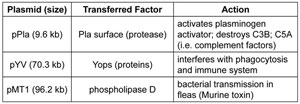Friday, February 19, 2016
Bubonic plague and deleterious mutations which deform, destroy, eradicate
No chance that monkeys became men, or fish the fisherman.
by StFerdIII
Why is there plague ? Why did 'God' allow the Bubonic plague to wipe out half of Europe's population between 1347-1352 – giving rise directly to the Ottoman Turk invasion and investiture of large swathes of the Continent during the 14th and 15th century. No men, no economy, no money, no armies.
The lamebrain media always chatters about 'mutations', as if they add benefits, or software 'differences'. They don't. Mutations kill, derange and destroy software information. The plague is an example of a micro-organism which lost genomic information due to mutations, and thus became lethal to humans. Today of course, the climate baloney industry would blame plant food for the rise of such a bacillus. [bold emphasis mine]
“Researchers hypothesize that key chromosomal genes (i.e. involved in metabolic pathways) were inactivated/lost in changing from a soil-inhabiting Yersinia to a pathogenic Yersinia species.2 Pathogenic Yersiniae have lost structural information and function in about 149 genes. Of these, 58 are the result of frameshift mutations,5 32 have undergone deletions, and the rest are nonsense mutations.6 These incomplete/inactivated genes or ‘pseudogenes’ are an important feature of the Y. pestis genome.7 ….
Genes added and moved
The corruption by three genes of a relatively benign recent ancestor of Y. pestis may have played a key role in the emergence of bubonic plague. Hinnebusch and colleagues, a plague expert team at the National Institutes for Health,8 maintains that the acquisition of two plasmid genes (i.e. just a few discrete genetic changes) in recent times changed the fairly harmless, Y. pseudotuberculosis, that causes mild food poisoning, to the agent of the ‘Black Death’. A third gene (carried on plasmid pMT1) produces murine toxin, an enzyme required for the initial survival of Y. pestis bacilli in the flea midgut (table 1).7 By acquiring this last gene from another organism, Y. pestis made a crucial shift in its host range, allowing it to survive in fleas, and devolved to relying on its blood-feeding host for transmission. This is just another example of the flexibility of many microbes in sometimes repackaging themselves into more dangerous agents of infectious disease.
Table 1. Virulence-associated plasmids of Yersinia pestis.8,9,10 Click here for larger view
This last corruption is one that distinguishes Yersinia pestis from all closely related, more benign bacteria such as Y. pseudotuberculosisand other Yersinia (e.g. Y. entercolitica).7 In turn, as Y. pestisadapted to rely on its new blood-feeding host for transmission, the emergence of more deadly bacterial strains would have been favoured. It appears that these minor plasmid additions10 were the last changes made in an otherwise long series of genetic losses in Y. pseudotuberculosis’ chromosome (figure 1).”
Genetic mutations are not beneficial. Of the 149 gene changes within the pathogenic Yersinae, none were beneficial. Zero. This should give the cult of Evolution pause when they suggest that fish became fishermen, or that lizard scales magically mutated into feather technology. Nonsense the whole lot of it.
======
-
Ryrie, C., Ryrie Study Bible (KJV), Moody Press, Chicago, IL, 1994.
-
Wren, B.W., The Yersiniae-a model genus to study the rapid evolution of bacterial pathogens, Nature Micro. Rev. 1(1):55-64, 2003 | PMID:15040180.
-
Plasmids are circular, double-stranded units of DNA that replicate within cells independently of the chromosomal DNA.
-
Lorange, E.A., Race, B.L., Sebbane, F. and Hinnebusch, B.J., Poor vector competence of fleas and the evolution of hypervirulence in Yersinia pestis, J. Infect. Dis. 191(11):1907-1912, 2005 | PMID: 15871125.
-
Frameshift mutations are changes in DNA where insertions or deletions of sequence occur that are not a multiple of three base pairs, thus disrupting the gene/protein normal code.
-
A nonsense mutation is any alteration of DNA that causes a codon representing an amino acid to be replaced by a termination codon.
-
Hinnebusch, B.J., Rudolph, A.E., Cherepanov, P., Dixon, J.E., Schwan, T.G., and Forsberg, A., Role of Yersinia murine toxin in survival of Yersinia pestis in the midgut of the flea vector, Science 296(5568):733-735, 2002 | PMID: 11976454.
-
Nester, E.W., et al., Microbiology: A Human Perspective, 4th ed, WCB McGraw-Hill Publishers, Boston, MA, 2004.
-
Parkhill, J., et al., Genome sequence of Yersinia pestis, the causative agent of plague, Nature 413(6855):523-527, 2001 | PMID: 11586360.
-
Hinnebusch B.J., Perry R.D. and Schwan T.G., Role of the Yersinia pestis hemin storage (hms) locus in the transmission of plague by fleas, Science273(5273):367-370, 1996 | PMID: 8662526.
